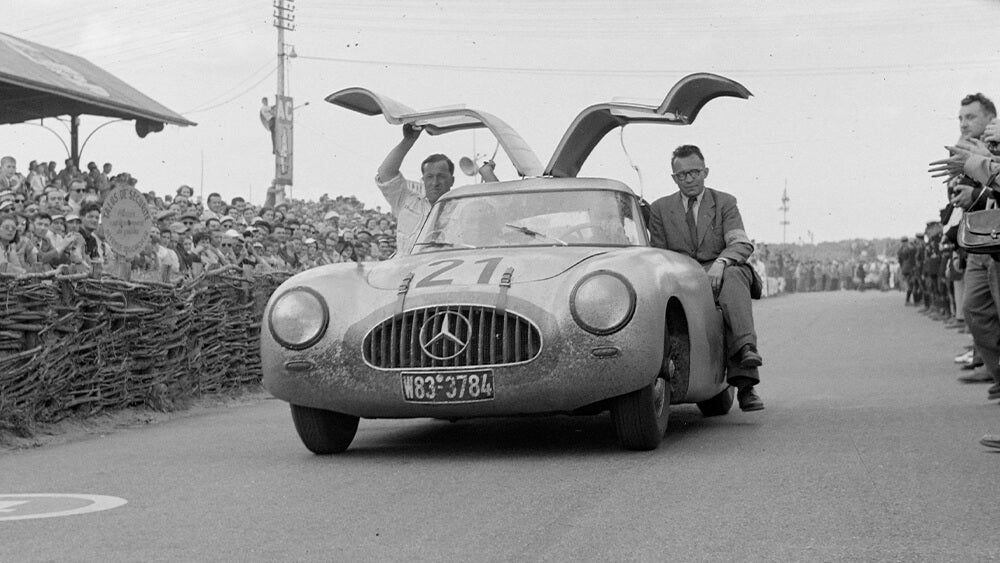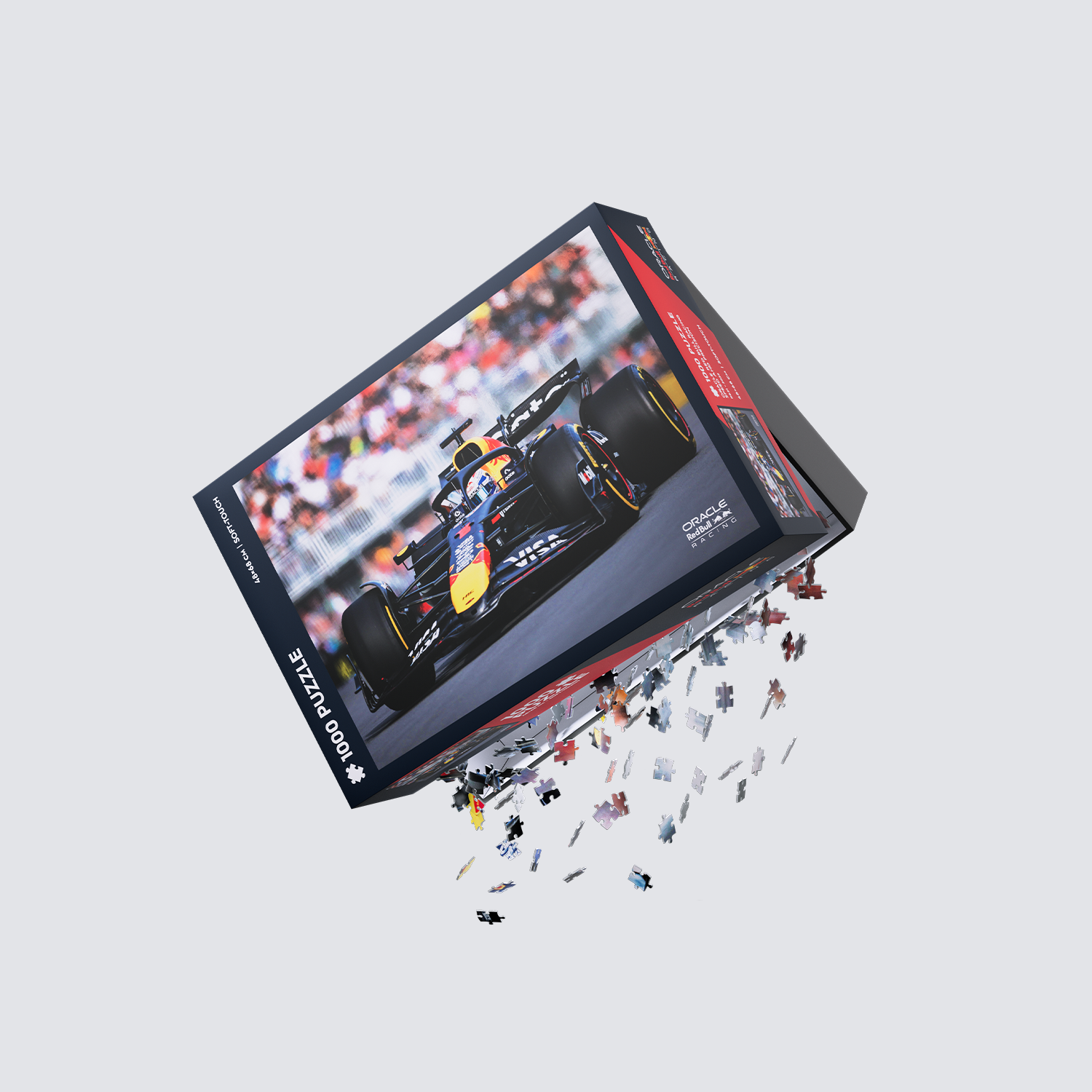24h Le Mans Centenary: 1943-1952 | Written by Richard Kelley
The creation of Mercedes’ legendary 1952 Le Mans-winning 300 SL began in the fertile mind of Rudolph Uhlenhaut. in 1947, the legendary chief engineer sketched a small Formula car with a 1500 cc transverse engine. Although never built, uhlenhaut never forgot that project’s lightweight lattice space frame.
Uhlenhaut assumed leadership of Mercedes’ racing department in 1936 and never looked back. His W125 dominated the 1937 Grand Prix season. Rule changes for 1938 brought about the new W154, which won six major GPs.
More than a decade later, the Mercedes-Benz board decided to return to motorsports for the 1952 season, choosing sports car racing, as the new Formula 1 championship was already too expensive. Once again, Mercedes called on Uhlenhaut. They christened their prototype challenger, W194.
 Three Mercedes-Benz 300 SLs (#20, #21 & #22) at the start of the 1952 24h Le Mans. Image Courtesy: Mercedes-Benz Group
Three Mercedes-Benz 300 SLs (#20, #21 & #22) at the start of the 1952 24h Le Mans. Image Courtesy: Mercedes-Benz Group
The only Mercedes powertrain remotely powerful enough was the off-the-shelf 3.0-litre inline-six from the decidedly non-sporting 300 Adenauer sedan. However, mating it with Uhlenhaut’s stillborn 1947 space-frame chassis project would ensure strength and rigidity with significantly less overall weight.
Uhlenhaut laid down the heavy engine at a 50-degree angle, replacing the oil pan with a dry-sump system, allowing a sleek, low hood. The engine acquired unique features, including an oblique cylinder head arrangement and overhead camshafts. He also specified all “glass” would be clear plastic.
One major hurdle remained. The complex 140-lb space-frame design required two large bulkheads running down the side of the car, blocking where conventional doors should reside. Uhlenhaut found the solution hidden among the 1952 24 Hours of Le Mans’ 73 pages of rules.
Article 34, Paragraph 2 revealed that "At least two permanent doors had to be fitted on either side of the body in such a way that permitted proper and direct access to the front seats." By massaging the rules, Uhlenhaut's W194 would instead have the "doors" hinged from the roof.
The resultant “gullwings” transformed the Mercedes 300SL, into a low, streamlined and efficient racing car that conquered Le Mans.
 Mercedes-Benz 300 SL (W194) with its iconic gullwing doors before the 1952 24h Le Mans. Image Courtesy: Motorsport Images
Mercedes-Benz 300 SL (W194) with its iconic gullwing doors before the 1952 24h Le Mans. Image Courtesy: Motorsport Images
Mercedes arrived at La Sarthe, led again by their pre-war team manager Alfred Neubauer came with a trio of W194 prototypes in the hands of Karl Kling and Hans Klenk, Hermann Lang and Fritz Riess and two German sports-car drivers, Helfrich and Niedermayer.
The three silver cars sported comfortable plaid seat upholstery with the surround of the radiator grille in green, blue and red for the respective pairs of drivers. Also, each racer had similar coloured identification lights in the front and rear of the cockpit.
Reminiscent of the 1930s, the Mercedes-Benz team practised with an unnerving air of calmness. The team cars were so well prepared that they arrived ready for practice, with the bonnets not even opened.
It wasn't surprising. The team's first warmup outing took both second and fourth in the Mille Miglia. The cars then scored first and second-place finishes at Bern.
 Hermann Lang / Fritz Riess lead the 1952 24h Le Mans in the Mercedes-Benz 300 SL (W194). Image Courtesy: Motorsport Images
Hermann Lang / Fritz Riess lead the 1952 24h Le Mans in the Mercedes-Benz 300 SL (W194). Image Courtesy: Motorsport Images
At the start, Jaguar and Ferrari jumped into the LeMans lead, with André Simon and Alberto Ascari trading lap records. Ascari set an absurd pace, putting the lap record up to 173.159 kph, with a lap in 4 min 40.5 sec, six seconds faster than Moss last year, and then retired with a slipping clutch. It was too much too early: two hours into the race, Ascari’s Ferrari 250S clutch exploded.
Simon’s Ferrari 340 America then led from the Robert Manzon / Jean Behra team and their 2.3-litre Gordini. Towards evening the two Frenchmen moved up into the lead.
By nightfall, all three Jaguars were out of the race in a dramatic change of fortune from the previous year. Two of the Aston Martins retired with differential failures. An alternator malfunction struck the Kling / Klenk team’s 300SL. At half-past midnight Hans Klenk abandoned the race.
After a pit stop, Pierre Levegh took his 4.5-litre Talbot into first place, 65 kilometres ahead of the 300SLs of the Helfrich / Niedermayr and Lang / Riess teams.
 Mercedes-Benz 300 SL (W194) during pit stop action at the 1952 24h Le Mans. Image Courtesy: Motorsport Images
Mercedes-Benz 300 SL (W194) during pit stop action at the 1952 24h Le Mans. Image Courtesy: Motorsport Images
By noon the following day, the number of competitors had dropped to 19 vehicles. Levegh still leads, stubbornly refusing to allow his teammate Marchand to relieve him.
With only two hours remaining and Levegh now four laps in front, the Frenchman decided to go the total distance single-handed. Behind him, the two 300SLs thundered on reliably, lap after lap. Levegh refused to relax while constantly lapping 15 seconds faster than the 1951-winning Jaguar.
Then, 70 minutes before the flag, a failed connecting rod forced Levegh to stop between Arnage and Maison Blanche.
The two 300 SLs were now unreachably far ahead. Earlier that morning, Hermann Lang had traded positions due to Theo Helfrich's driving error. In an instant, Lang now brought Mercedes-Benz victory at the 24 Hours of Le Mans.
It would be Mercedes' one and only Le Mans victory until it finally won again in 1989.
 Hermann Lang with Fritz Riess in the background during celebrations after winning the 1952 24h Le Mans in their Mercedes-Benz 300 SL (W194). Image Courtesy: Motorsport Images
Hermann Lang with Fritz Riess in the background during celebrations after winning the 1952 24h Le Mans in their Mercedes-Benz 300 SL (W194). Image Courtesy: Motorsport Images
Undoubtedly, the 1952 300 SL remains one of history's most iconic racing cars. Designed to be reliable and competitive from the off, it is a massively impressive example of intention in an era when reliability wasn't always a racing car's strong point.
Follow the link below to read more stories from the 100 years of 24h Le Mans and discover our celebratory poster collection created in cooperation with the Automobile Club de l'Ouest.














































